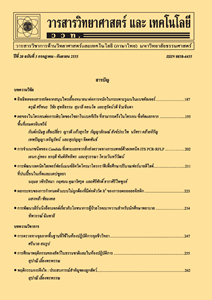การตรวจคัดกรองการติดเชื้อ Mycobacterium leprae ในผู้ป่วยโรคเรื้อนประเภทเชื้อน้อยโดยชุดทดสอบทางภูมิคุ้มกันวิทยาชนิดรวดเร็ว
Main Article Content
Abstract
Paucibacillary (PB) is leprosy patients infected with Mycobacterium leprae whom have strongly moderate to moderate cell mediated immune response (CMI) causing no clinical symptom in most patients. Treatment and prevention report in 2005 proposed that approximately 27.32 percent of leprosy were new cases of PB patients. Detection of leprosy relies on cardinal signs with or without positive AFB from SSS testing. Clearly signs without positive result of AFB were diagnosis as PB patients. However, some suspected leprosy showed ambiguous skin lesion or nerve involvement resulting in mis- or late diagnosis. The patients can develop to MB patients causing poor prognosis and finally disability. Moreover, they also spread M. leprae throughout the household or contact person. These are not only public health problem but also a socio-economic problem. Therefore, immunological testing which has high sensitive, specific and early diagnosis has been developed. The study aims to investigate the efficacy of Leprosy IDRI Diagnostic 1 (LID-1) rapid serological test. Whole blood was collected from 10 samples of normal blood and 10 samples of PB patients with negative AFB from SSS testing. All samples were analyzed LID-1 rapid serological test. Slit skin smear were done and confirmed M. leprae infection with PCR method in PB patients. The LID-1 rapid serological test showed that 11 samples (55 %) were negative results and 9 samples (45 %) were positive results. Only 60 % of PB patients found M. leprae when analyzed by PCR method. Efficiency evaluation of LID-1 rapid serological testing with cardinal signs represented that the LID-1 rapid serological test has 45 % of true positive, 50 % of true negative and 5 % of false negative with on false positive. These were corresponded to 90 % sensitivity, 100 % specificity, 100 % positive predictive value, 91 % negative predictive value and 0.1 % negative likelihood ratio. Therefore, the LID-1 rapid serological test can be useful in primary screening which could reduce the cost of leprosy diagnosis and early diagnosis. In addition, it is non-invasive method so it also suitable for patients that didn’t wanted to examine with SSS test. LID-1 rapid serological test will be very useful in the population that needs leprosy diagnosis, such as migrant worker and household contact to prevent the progression of the disease.
Keywords: paucibacillary leprosy; rapid serological test; screening test
Article Details
References
[2] สถาบันราชประชาสมาสัย, 2557, รายงานอุบัติการณ์จากงานรักษาและป้องกันควบคุมโรคเรื้อน, น. 24-27, กรมควบคุมโรค, สมุทรปราการ.
[3] สำนักงานบริหารคนงานต่างด้าว, 2557, สถิติรายปีคนงานต่างด้าวประจำปี 2557, เอกสารเผยแผ่, กรมการจัดหางาน, กรุงเทพฯ.
[4] Duthie, M.S., Goto, W., Ireton, G.C., Reece, S.T., Cardoso, L.P.V., Martelli, C.M.T., Stefani, M.M.A., Nakatani, M., de Jesus, R.C., Netto, E.M., Balagon, M.V.F., Tan, E., Gelber, R.H., Maeda, Y., Makino, M., Hoft, D. and Reed, S.G., 2007, Use of protein antigens for early serological diagnosis of leprosy, Clin. Vaccine Immunol. 14: 1400-1408.
[5] Meeker, H.C., Schuller-Levis, G., Fusco, F., Giardina-Becket, M.A., Sersen, E. and Levis, W.R., 1990, Sequential monitoring of leprosy patients with serum antibody levels to phenolic glycolipid-I, a synthetic analog of phenolic glycolipid-I, and mycobacterial lipoarabinomannan, Int. J. Lepr. Other Mycobact. Dis. 58: 503-511.
[6] Brennan, P.J. and Barrow, W.W., 1980, Evidence for species-specific lipid antigens in Mycobacterium leprae, Int. J. Lepr. Other Mycobact. Dis. 48: 382-387.
[7] Shepard, C.C. and McRae, D.H., 1968, A method for counting acid-fast bacteria, Int. J. Lepr. Other Mycobact. Dis. 36: 78-82.
[8] Paula Vaz Cardoso, L., Dias, R.F., Freitas, A.A., Hungria, E.M., Oliveira, R.M., Collovati, M., Reed, S.G., Duthie, M.S. and Martins Araújo Stefani, M., 2013, Development of a quantitative rapid diagnostic test for multibacillary leprosy using smart phone technology, BMC Infect. Dis. 13: 497.
[9] Turankar, R.P., Pandey, S., Lavania, M., Singh, I., Nigam, A., Darlong, J., Darlong, F. and Sengupta, U., 2015, Comparative evaluation of PCR amplification of RLEP, 16S rRNA, rpoT and Sod A gene targets for detection of M. leprae DNA from clinical and environmental samples, Int. J. Mycobacteriol. 4: 54-59.
[10] Martinez, A.N., Talhari, C., Moraes, M.O. and Talhari, S., 2014, PCR-based techniques for leprosy diagnosis: From the laboratory to the clinic, PLoS Negl. Trop. Dis. 8(4): e2655.
[11] de Wit, M.Y., Faber, W.R., Krieg, S.R., Douglas, J.T., Lucas, S.B., Montreewasuwat, N., Pattyn, S.R., Hussain, R., Ponnighaus, J.M. and Hartskeerl, R.A., 1991, Application of a polymerase chain reaction for the detection of Mycobacterium leprae in skin tissues, J. Clin. Microbiol. 29: 906-910.
[12] Duthie, M.S., Balagon, M.F., Maghanoy, A., Orcullo, F.M., Cang, M., Dias, R.F., Collovati, M. and Reed, S.G., 2014, Rapid quantitative serological test for detection of infection with Mycobacterium leprae, the causative agent of leprosy, J. Clin. Microbiol. 52: 613-619.


